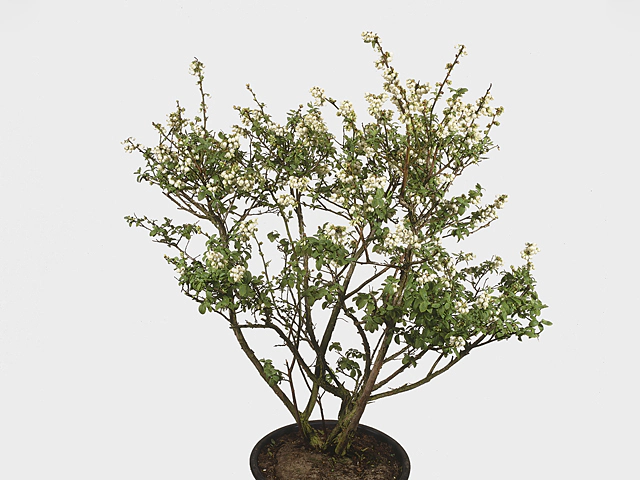Vaccinium corymbosum

| Fruit type | Berry |
| Fruit shape | Rounded/globose |
| Leaf type | Foliage leaf |
| Winter hardness | Good (USDA-zone 5, 6) |
| Flower color | Yellow; White-white-155D |
| Fruit color | Blue |
| Leaf, general shape | Ovate (egg-shaped); Elliptic / oval |
| Flower diameter | Small; 1 - 10 mm |
| Plant height | 1,2 - 1,4 m; 1,8 - 2 m |
| Inflorescence | Raceme |
| Flowering month(s) | May |
| Fruit size | Medium |
| Leaf duration | Deciduous |
| Flowering period | Spring flowering |
| Leaf size | 5 - 7,5 cm; 3 - 4 cm |
| soil pH requirement | Acid (pH < 4,5); Slightly acidic (pH 4,5 - 6,5) |
| Light conditions | Sunny; Semi-shades |
| Leaf division | Simple |
| Pollination/fertility | Recommended |
| Leaf, main color | Dark green |
| Fruit, maturing period | July; August |
| Leaf colour, pattern | Unicolored |
| Flower, secondary color(s) | Dark pink red |
| Moisture requirements | Well-drained; Moist |
Bilberry, also known as highbush blueberry, blue berry, huckleberry, or blueberry, is a fruit that belongs to the Vaccinium corymbosum species. It is a small berry, with a rounded or globose shape. The fruit has a blue color, which gives it its various names.
The bilberry plant is known for its winter hardness, being able to withstand cold temperatures in USDA-zone 5 and 6. It has foliage leaves, which means it sheds its leaves in the winter months. The leaves have an ovate or elliptic shape, resembling an egg or oval. They are generally dark green in color and grow to be around 5-7.5 cm long and 3-4 cm wide.
During the spring months, the bilberry plant produces yellow or white flowers that are small in size, with a diameter ranging from 1 to 10 mm. The flowers are arranged in racemes, creating a beautiful inflorescence. The flowering period is usually in May.
In terms of height, the bilberry plant can grow to be between 1.2 and 1.4 meters or 1.8 and 2 meters tall. It thrives in sunny or semi-shaded light conditions and requires well-drained or moist soil. The plant prefers slightly acidic to acidic soil with a pH range of less than 4.5 to 6.5.
Pollination is recommended for the bilberry plant to ensure fertility and the production of fruit. The fruit itself is medium-sized and matures in July and August. It is known for its rich blue color and is often harvested for consumption or used in various culinary creations.
Bilberry plants have a deciduous leaf duration, meaning they lose their leaves in the winter. The leaves have a unicolored pattern and are prominently dark green. They are divided into simple leaf divisions, which contribute to their ovate or elliptic shape.
Overall, the bilberry plant is a hardy and attractive addition to any garden or landscape. Its beautiful flowers, colorful fruit, and lush foliage make it a popular choice for both aesthetic and edible purposes. With the right conditions and care, bilberry plants can thrive and provide a bountiful harvest of delicious and nutritious berries.
Market availability index by month:
| Jan. | Feb. | Mar. | Apr. | May | Jun. | Jul. | Aug. | Sep. | Oct. | Nov. | Dec. |
|---|---|---|---|---|---|---|---|---|---|---|---|
| 1 | 3 | 3 | 3 | 4 | 1 | 1 | 1 | 2 | 1 | 1 | 1 |